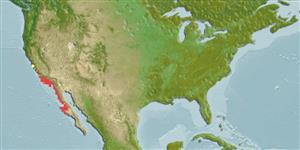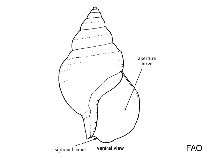Kelletia kelletii (Forbes, 1850)
Kellet's whelk| Native range | All suitable habitat | Point map | Year 2050 |

|
| This map was computer-generated and has not yet been reviewed. |
| Kelletia kelletii AquaMaps Data sources: GBIF OBIS |
Upload your photos
Google image | No image available for this species;
drawing shows typical species in Buccinidae.
Google image | No image available for this species;
drawing shows typical species in Buccinidae.
Classification / Names Common names | Synonyms | CoL | ITIS | WoRMS
Gastropoda | Neogastropoda | Buccinidae
Environment: milieu / climate zone / depth range / distribution range Ecology
Benthic; depth range 0 - 69 m (Ref. 865), usually 3 - 40 m (Ref. 106100). Subtropical; 37°N - 27°N, 123°W - 113°W
Distribution Countries | FAO areas | Ecosystems | Occurrences | Introductions
Eastern Central Pacific: USA to Mexico. From Isla Asuncion, Baja California, Mexico to Monterey, CA, USA.
Length at first maturity / Size / Weight / Age
Maturity: Lm ?, range 7 - 9 cm Max length : 17.5 cm SHL male/unsexed; (Ref. 865); common length :8.5 cm SHL (female)
It is found in kelp beds on rocky and soft bottoms, from low intertidal to a depth of 69 meters (Ref. 865). Also inhabits sand areas adjacent to more solid substratum. Forms aggregated distribution patterns, most likely as a foraging and/or reproductive strategy. Carnivorous scavenger. Primarily feeds on live sessile polychaetes and solitary tunicates (Ref. 101624).
Life cycle and mating behavior Maturity | Reproduction | Spawning | Eggs | Fecundity | Larvae
Members of the order Neogastropoda are mostly gonochoric and broadcast spawners (Ref. 833). Life cycle: Eggs capsules (400 to 1200 eggs) are deposited on hard substrate. Embryos develop within the capsule, emerge into the water column as free-swimming veliger larvae and later assumes a benthic life style (Ref. 104623).
Main reference
References | Coordinator | Collaborators
Bisby, F.A., M.A. Ruggiero, K.L. Wilson, M. Cachuela-Palacio, S.W. Kimani, Y.R. Roskov, A. Soulier-Perkins and J. van Hertum. 2005. (Ref. 19)
IUCN Red List Status (Ref. 130435)
CITES status (Ref. 108899)
Not Evaluated
CMS (Ref. 116361)
Not Evaluated
Threat to humans
Human uses
Fisheries: commercial
| FishSource |
Tools
More information
Age/Size
Growth
Length-weight
Length-length
Morphology
Larvae
Abundance
Growth
Length-weight
Length-length
Morphology
Larvae
Abundance
Internet sources
BHL | BOLD Systems | CISTI | DiscoverLife | FAO(Publication : search) | Fishipedia | GenBank (genome, nucleotide) | GloBI | Gomexsi | Google Books | Google Scholar | Google | PubMed | Tree of Life | Wikipedia (Go, Search) | Zoological Record
Estimates based on models
Preferred temperature
(Ref. 115969): 14.5 - 18.8, mean 16.7 (based on 10 cells).
Price category
(Ref. 80766):
Unknown.



